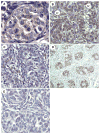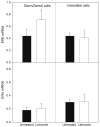Expression of P-450 aromatase, estrogen receptor α and β, and α-inhibin in the fetal baboon testis after estrogen suppression during the second half of gestation
- PMID: 21061091
- PMCID: PMC3381799
- DOI: 10.1007/s12020-010-9414-5
Expression of P-450 aromatase, estrogen receptor α and β, and α-inhibin in the fetal baboon testis after estrogen suppression during the second half of gestation
Abstract
Expression of the molecules that modulate the synthesis and action of estrogen in, or reflect function of, Sertoli cells was determined in the fetal testis of baboons in which estrogen levels were suppressed in the second half of gestation to determine whether this may account for the previously reported alteration in fetal testis germ cell development. P-450 aromatase, estrogen receptor (ER) β, and α-inhibin protein assessed by immunocytochemistry was abundantly expressed in Sertoli cells of the fetal baboon testis, but unaltered in baboons in which estrogen levels were suppressed by letrozole administration. Moreover, P-450 aromatase and ERα and β mRNA levels, assessed by real-time RT-PCR, were similar in germ/Sertoli cells and interstitial cells isolated from the fetal testis of untreated and letrozole-treated baboons. These results indicate that expression of the proteins that modulate the formation and action of estrogen in, and function of, Sertoli cells is not responsible for the changes in germ cell development in the fetal testis of estrogen-deprived baboons.
Figures






Similar articles
-
Estrogen promotes germ cell and seminiferous tubule development in the baboon fetal testis.Biol Reprod. 2009 Aug;81(2):406-14. doi: 10.1095/biolreprod.108.073494. Epub 2009 Apr 29. Biol Reprod. 2009. PMID: 19403930 Free PMC article.
-
Developmental regulation of baboon fetal ovarian maturation by estrogen.Biol Reprod. 2002 Oct;67(4):1148-56. doi: 10.1095/biolreprod67.4.1148. Biol Reprod. 2002. PMID: 12297530
-
Expression of estrogen receptors alpha and beta in the fetal baboon testis and epididymis.Biol Reprod. 2004 Apr;70(4):1106-13. doi: 10.1095/biolreprod.103.022665. Epub 2003 Dec 10. Biol Reprod. 2004. PMID: 15033877
-
Regulation of baboon fetal ovarian folliculogenesis by estrogen.Mol Cell Endocrinol. 2006 Mar 9;247(1-2):41-6. doi: 10.1016/j.mce.2005.11.045. Epub 2006 Jan 18. Mol Cell Endocrinol. 2006. PMID: 16420971 Review.
-
Aromatase and oestrogens in human male germ cells.Int J Androl. 2005 Oct;28(5):254-9. doi: 10.1111/j.1365-2605.2005.00546.x. Int J Androl. 2005. PMID: 16128984 Review.
Cited by
-
Adult stem cell transplantation: is gender a factor in stemness?Int J Mol Sci. 2014 Aug 28;15(9):15225-43. doi: 10.3390/ijms150915225. Int J Mol Sci. 2014. PMID: 25170809 Free PMC article. Review.
-
Expression and localization of aromatase during fetal mouse testis development.Basic Clin Androl. 2013 Dec 1;23:12. doi: 10.1186/2051-4190-23-12. eCollection 2013. Basic Clin Androl. 2013. PMID: 25780574 Free PMC article.
-
Estrogens and development of the rete testis, efferent ductules, epididymis and vas deferens.Differentiation. 2021 Mar-Apr;118:41-71. doi: 10.1016/j.diff.2020.11.004. Epub 2020 Dec 13. Differentiation. 2021. PMID: 33441255 Free PMC article.
-
The battle of the sexes for stroke therapy: female- versus male-derived stem cells.CNS Neurol Disord Drug Targets. 2013 May 1;12(3):405-412. doi: 10.2174/1871527311312030013. CNS Neurol Disord Drug Targets. 2013. PMID: 23469849 Free PMC article. Review.
References
-
- Gondos B, et al. Z Zellforsch Mikrosk Anat. 1971;119:1. - PubMed
-
- Aslan AR, Kogan BA, Gondos B. In: Neonatal Physiology Fetal. Polin RA, Fox WW, Abman SH, editors. W.B. Saunders; Philadelphia: 2004.
-
- O’Shaughnessy PJ, Baker PJ, Monteiro A, Cassie S, Bhattacharya S, Fowler PA. J Clin Endocrinol Metab. 2007;92:4792–4801. - PubMed
-
- Gaskell TL, Esnal A, Robinson LL, Anderson RA, Saunders PT. Biol Reprod. 2004;71:2012–2021. - PubMed
Publication types
MeSH terms
Substances
Grants and funding
LinkOut - more resources
Full Text Sources

